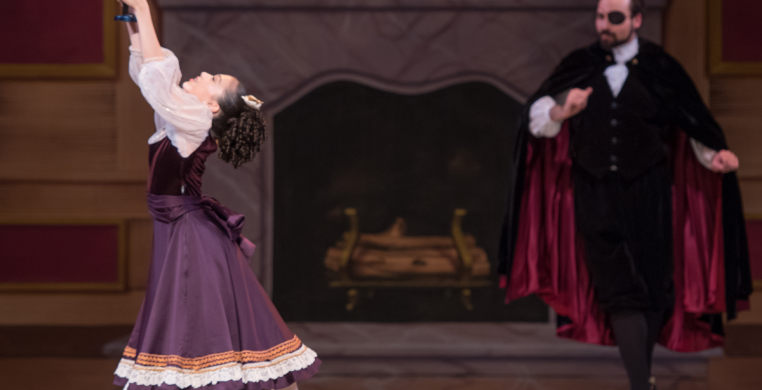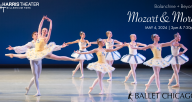Ballet Chicago wrapped up its 2023 season with sparkling performances of The Nutcracker at Chicago’s Athenaeum Center and The Harris Theater December 8-17. Professional guest artists joined dancers from Ballet Chicago’s semi-professional studio company, students from the Ballet Chicago student and preparatory divisions, and the Tutu School Chicago. Make no mistake, there was nothing “semi” about the production.
Marius Petipa’s original Nutcracker Ballet premiered in St. Petersburg, Russia in 1892, highlighting Czarist Russian opulence and a diversity of tasty treats from around the world. The message was the magic of Christmas and the “make believe” of childhood innocence, especially if you can afford to live like the aristocracy.
Christopher Wheeldon’s reimagining of The Nutcracker for The Joffrey Ballet (2016), paints a very different picture of that magic, through the lens of poverty and the 1893 World’s Fair Columbian Exhibition. The message is you don’t have to be rich to be kind and generous. In this version, compassion and loving kindness bridge the worlds of the haves and have-nots.
Ballet Chicago’s 2023 iteration of the classic holiday entertainment expands on the celebration of diversity across a rainbow of cultures, body sizes and shapes, geographic origins, and age. The message is inclusiveness—we are all part of the same family, united by the universal brother-and-sisterhood of humanity.
Similar to George Balanchine’s original choreography for the New York City Ballet’s Nutcracker (1954), Ballet Chicago Artistic Director Daniel Duell and Associate Artistic Director Patricia Blair’s production (1998) maintains fidelity to Marius Petipa’s original concept, and includes Balanchine's Sugar Plum Fairy Pas De Deux.
No strangers to Balanchine, Duell was a dancer with the New York City Ballet (1972-1987) and was a principal with the company beginning in 1979. He danced the role of Cavalier Prince under Mr. B’s direction of City Ballet’s production of The Nutcracker. Blair studied at Balanchine’s School of American Ballet (SAB) and danced Balanchine repertory as a member of the Eglevsky Ballet.
While SeeChicagoDance is committed to covering professional dance in Chicago, Ballet Chicago is unique among the city’s other fine studio companies and warrants special coverage. As the only dance company in the Midwest licensed by the Balanchine Trust to teach, stage, and perform the works of George Balanchine, Ballet Chicago offers Chicago audiences their most frequent opportunity to see his work.
I was lucky enough to see performances at both the Athenaeum Center and The Harris Theater, each offering a uniquely distinct performance perspective. The Athenaeum is housed in a converted church parish building next to the towering gothic spires of St. Alphonsos Catholic church in a melting pot Chicago neighborhood at the intersection of Southport and Lincoln, where you can grab a great pre-show meal at an all-night diner across the street.
Restaurant patrons include families with young children decked out in holiday party clothes, urban and suburban parents of young cast members, and neighborhood regulars— old-timers, hip 30-somethings, singles and mix and match couples of all shapes, sizes and age. The wait staff, which ranges in age from 30-ish to 70-ish, can be heard conversing in Spanish, Arabic, and English, and the owner stands at the front of the restaurant to greet you. Any or all might show up in the audience at the Athenaeum after dinner. It’s a neighborhood thing.
The Harris, situated on Randolph Street and Michigan Avenue, Chicago’s main north-south thoroughfare at the edge of downtown Chicago’s Millennium Park, is surrounded by towering skyscrapers, office buildings, and bustling traffic. You can choose from a variety of high-end restaurants and bars for pre- or post-show refreshment. Anonymous throngs of people flock to the Harris for music, dance, and multi-disciplinary events.
As Chicago’s oldest continuously operating theater, the Athenaeum Center, dates back to 1911. Its intimate, 984-seat Edwardian interior wraps its audiences’ main floor and balcony seats in the embrace of gold and white rococo archways and domed ceiling. Sight lines are excellent.
The much larger Harris—1,525 seats— is a subterranean modern marvel, with the stage at the bottom of a long, steeply-pitched flight of steps. Patrons flood the entrance and lobby, and you’re lucky to squeeze into the packed elevator for a ride down to the main floor, followed by a precipitous descent to your seat. The broad proscenium curtain opens onto a stage half as large as the Athenaeum’s.
While Ballet Chicago is one of the Harris Theater’s performing arts partners, this year was Ballet Chicago’s first time staging the Nutcracker there. Duell and Blair wanted their Nutcracker to reach audiences from downtown Chicago, the Near North and South sides, and points south and west. The Harris’s easy access to major expressways accommodated that goal. What was gained and what lost?
Certainly exposure at the Harris was a plus, and the dancers’ performances at both venues were equally fine. In addition, Duell explained, it gave his young dancers the experience oof adapting to different audiences, different spaces, and most importantly, different roles. Miraculously, Blair and Duell managed to give their Ballet Chicago dancers an opportunity to dance different roles in every performance.
For this dance writer, the charm and intimacy of the Athenaeum Center suits Ballet Chicago’s Nutcracker to a T, perhaps because it is such a family affair, unlike other Ballet Chicago concert dance performances I have enjoyed at the Harris.
At both venues, the “Snow” scene, which closes Act One, stands out as one of the most beautiful I have ever seen. A wonder of visual spectacle, it transports the viewer into the beauty of a winter snowstorm. The combination of movement, lighting, music, choreographic representation of snowflakes through physical gesture and lacy pointe work, and spatial design of the corps de ballet created a magical transition into Act Two.
“We wanted the dancing to carry through real balletic dance, even down to the youngest dancers,” Duell said during a recent phone interview. Musicality is of prime importance in his and Blair’s teaching and artistic direction. Duell, a trained musician, spliced the score for Ballet Chicago’s Nutcracker, bringing the running time down to a family-friendly two hours.
Duell’s musical intuition resonated throughout the luscious Waltz of the Flowers as well, again with utmost attention to the confluence of visual spectacle, choreographic design of the corps de ballet, and sensitivity to Tchaikovsky’s musical nuances.
Studio Company members Blair Mendes and Nikyle Scott couldn’t be matched for perfection as the Sugar Plum Fairy and her Cavalier Prince. Emma Wittig and Tyler Bianchi, fellow Studio Company members, also shone brightly as Snow Queen and Snow King.
Josh Ishmon, on loan from Deeply Rooted Dance Theater, brought both humor and mystique to his delightful portrayal of Drosselmeyer, complete with eyepatch and dreadlocks. As master of ceremonies, his tenderness with the children and seasoned command of the stage charmed at the Athenaeum and expanded in range to fill The Harris.
Ballet Chicago veteran and Resident Choreographer Ted Seymour as Dr. Stahlbaum and Morgan Jankowski as Mrs. Stahlbaum were gracious hosts in the Party scene of Act One, delivering American Girl dolls—a major Ballet Chicago sponsor—and trumpets to the juvenile party guests. Storytelling (dramatic action) was especially strong in both of their portrayals.
Emma Wittig and Montes Pirtle warmed the house as Hot Chocolate. Pirtle is especially charismatic and someone to watch.
Little Katelyn Park as Marie lit up the stage with charm to spare, impressive technical skill, and dramatic flair.
Claudia Kantner and Kayla Schmitt distinguished themselves, alternating as Dew Drop in Waltz of the flowers, and 18-year-old Tyler Bianchi and Montes Pirtle both knocked my socks off alternating as “Ukranian Babka,” otherwise known as “Russian Cossack,” with barrel turns, “kazatsky” kicks and tours á la seconde that brought down the house.
All in all, Ballet Chicago’s Nutcracker embodies the artistic integrity of a fully- professional company, while delivering a seasonal message of true diversity, inclusiveness, and love that few companies achieve.


